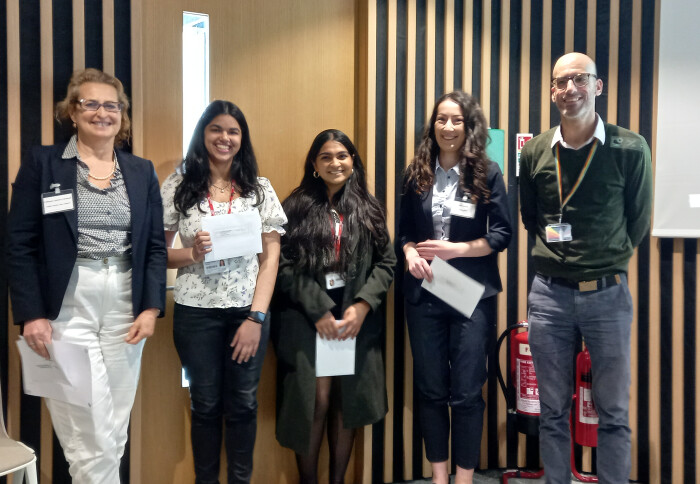

Experts from across Imperial discussed the latest research progress in vascular dementia, the second most common type of dementia after Alzheimer's.
Jointly hosted by the British Heart Foundation (BHF) Centre for Research Excellence (CRE) and the UK Dementia Research Institute (DRI) Centre at Imperial, the symposium brought together experts to discuss emerging insights into vascular dementia care and treatment.
Professors Martin Wilkins, BHF CRE Director, and Paul Matthews, DRI Centre Director, opened the session. Professor Wilkins discussed the existing partnership between the UK DRI and BHF CRE , outlining key research conducted by Professor Ioanna Tzoulaki and Professor Paresh Malhotra , and funded by the BHF CRE. He envisaged that one of the main outcomes of the symposium is likely to be future joint collaborative research opportunities for vascular dementia between the UK DRI and CRE as well as universities across the UK.
Setting the scene, Professor Matthews said: “The UK DRI has taken on a number of challenges that have been neglected over a long time. One of the most important is the role vascular dysfunction plays in late life of dementia.
“This workshop has highlighted that we are at a turning point in science. It's an exciting time! We have the tools and are developing the people. We are bringing understanding of different diseases that share common comorbidities together to realise new strategies for therapeutics and care. The two DRI centres and the BHF Centre of Excellence together are absolutely committed to this.
“I am confident that we now can start moving ever more rapidly from ideas to impact for patients.”
The talks covered a wide range of topics, from the pathology of vascular dementia to using data science to drive forward experimental dementia research, as well as emerging translational studies. The day was divided into key sessions – Dr Sonya Babu-Narayan, Deputy Director at the BHF was present and chaired one of the sessions.
Dr Graeme Birdsey, Senior Lecturer in Vascular Science at the National Heart and Lung Institute (NHLI), described his group’s recent work uncovering the molecular mechanisms through which genetic variants of the transcription factor ERG cause the dysfunctional lymphatic vessels. Dr Birdsey commented: “Recent exciting discoveries have highlighted how lymphatic vessels in the brain meninges are thought to play a key role in clearing toxic by-products, which contribute to the pathogenesis of Alzheimer's disease. Uncovering the molecular pathways which regulate the meningeal lymphatic vessels could allow manipulation of these vascular networks for the treatment of neurodegenerative diseases.”
Dr Alexi Nott, Lecturer in Neurogenomics and UK DRI Group Leader, spoke about using genome-wide sequencing approaches to examine the epigenome of the human brain in order to understand how genetic variation contributes to age-related brain disorders such as Alzheimer’s. Dr Nott noted: “Some of the challenges in interpreting this data is that the majority of these risk variants are located outside of genes. They're located in non-coding regions of the genome, and the non-coding nature of these DNA risk variants has led people to hypothesise that they could be altering the function of regions called enhancers.”
Professor Dennis Wang, Chair in Data Science at the NHLI, described the application of machine learning techniques to Alzheimer’s-related features extracted from neuropathology assessments of the brain. Professor Wang noted: “We can use machine learning techniques called feature ranking methods to compare cognitive decline in ageing individuals to the features measured in pathological assessments, such as the spread of amyloid deposits in the brain and arteries. This enables us to simultaneously assess the impact of neuronal and cardiovascular pathologies on cognitive decline.”
Dr Prashant Srivastava, Lecturer in Cardiovascular Bioinformatics and Medical Statistics at the NHLI, spoke about the intricate relationship between the heart and brain. Specifically, he discussed the significant impact of coronary artery disease on the development of dementia. His presentation shed light on the bidirectional relationship between the two systems, deepening our understanding of their interplay and its broader implications.
Dr Otavio Berwanger, Executive Director of The George Institute for Global Health and Chair in Public Health at Imperial, commenced the afternoon session by discussing whether intensive blood pressure lowering could reduce the risk of dementia. Dr Berwanger cautioned: “Currently we have about 1.3 billion people around the world living with hypertension. Not only is it very common, but it also accounts for about half of all heart disease and stroke-related death and we can also discuss the burden related also to dementia.”
Dr Fatemeh Geranmayeh, Clinician Scientist and proleptic Senior Clinical Lecturer at the Department of Brain Sciences, spoke about the IC3 Study (The Imperial Comprehensive Cognitive Assessment in Cerebrovascular Disease), which aims to predict the trajectory of cognitive recovery in patients with cerebrovascular disease using novel brain and blood biomarker. Dr Geranmayeh said: “By the time we are 80, fourty per-cent of us will have silent strokes … and following stroke, a third of patients will have persistent cognitive impairment, and a third have acute language problems, so it’s a major clinical problem. Predicting the recovery of cognition is not an easy task, as patients are heterogenous and are already on various decline trajectories.”
A poster session was also held, and posters were submitted by junior members of the DRI and the NHLI. These were displayed and judged by a panel lead by Professor Edwin Chilvers. The three best posters were presented with prizes by BHF Chairholder, Professor Costanza Emanueli and Dr Alexi Nott. The best poster prize was awarded to Ms Sejal Singal from Professor Julia Gorelik’s lab. Professor Gorelik also completed a talk on ‘Functional microscopy methods for studying neuro - muscular junctions in the heart’. Runner-up prizes were awarded to Ms Shivani Sinha and Ms Andrea Braban.
Closing the sessions, Professor Matthews said: “I want to reflect for a moment on how important the day has been. It’s shown how the BHF Centre of Excellence can achieve the aim of providing an aggregate for scientists sharing common aims. It’s also shown how exciting interdisciplinary sciences – where one pulls together people with different backgrounds and different immediate goals – and sparks can begin to fly. This is the future of this science. Science is going to be increasingly more joined together, just as I hope our clinical care will be.”
Article text (excluding photos or graphics) © Imperial College London.
Photos and graphics subject to third party copyright used with permission or © Imperial College London.
Reporter
Lou Lee
Faculty of Medicine Centre

Contact details
Tel: +44 (0)20 7594 2103
Email: louisa.lee@imperial.ac.uk
Show all stories by this author



